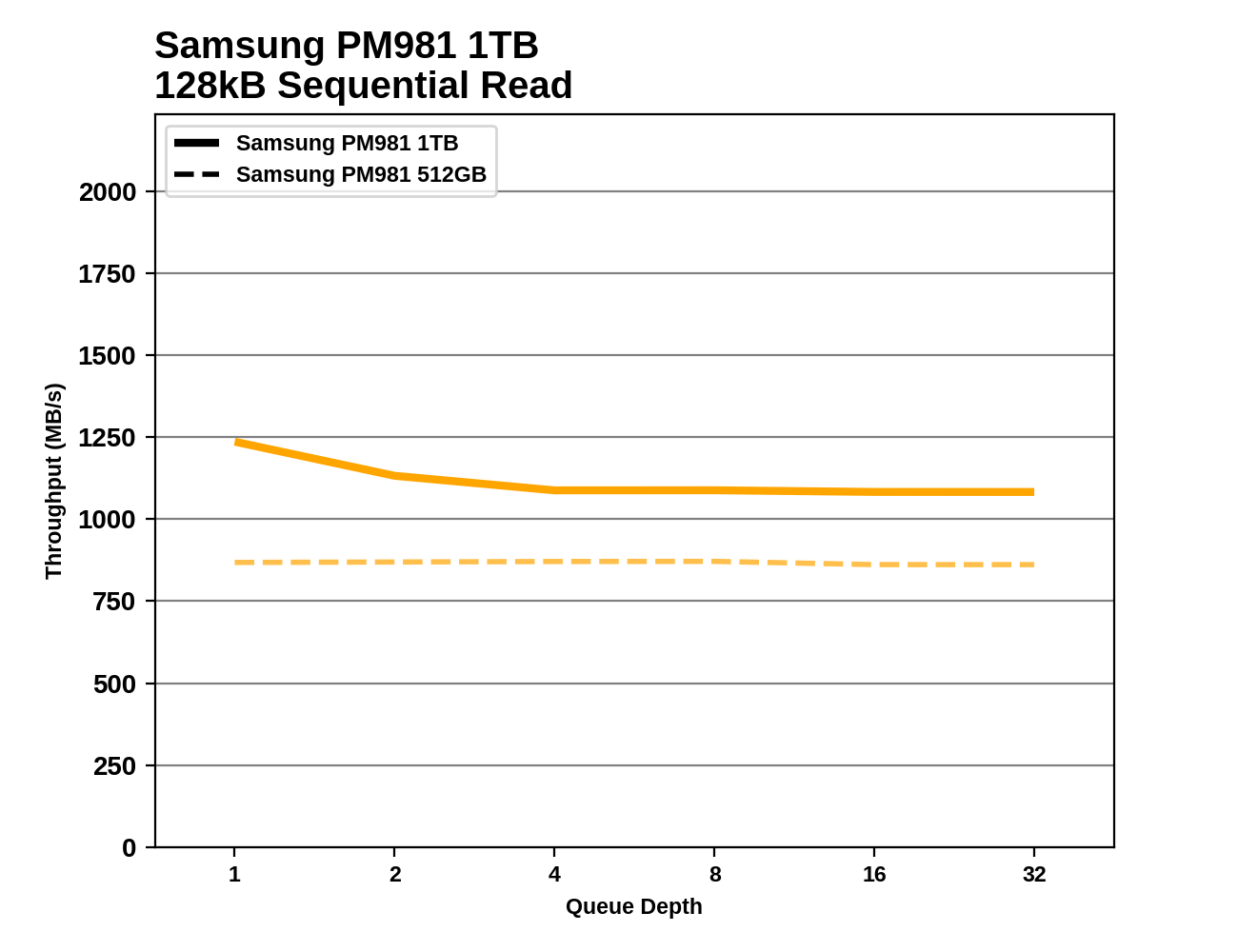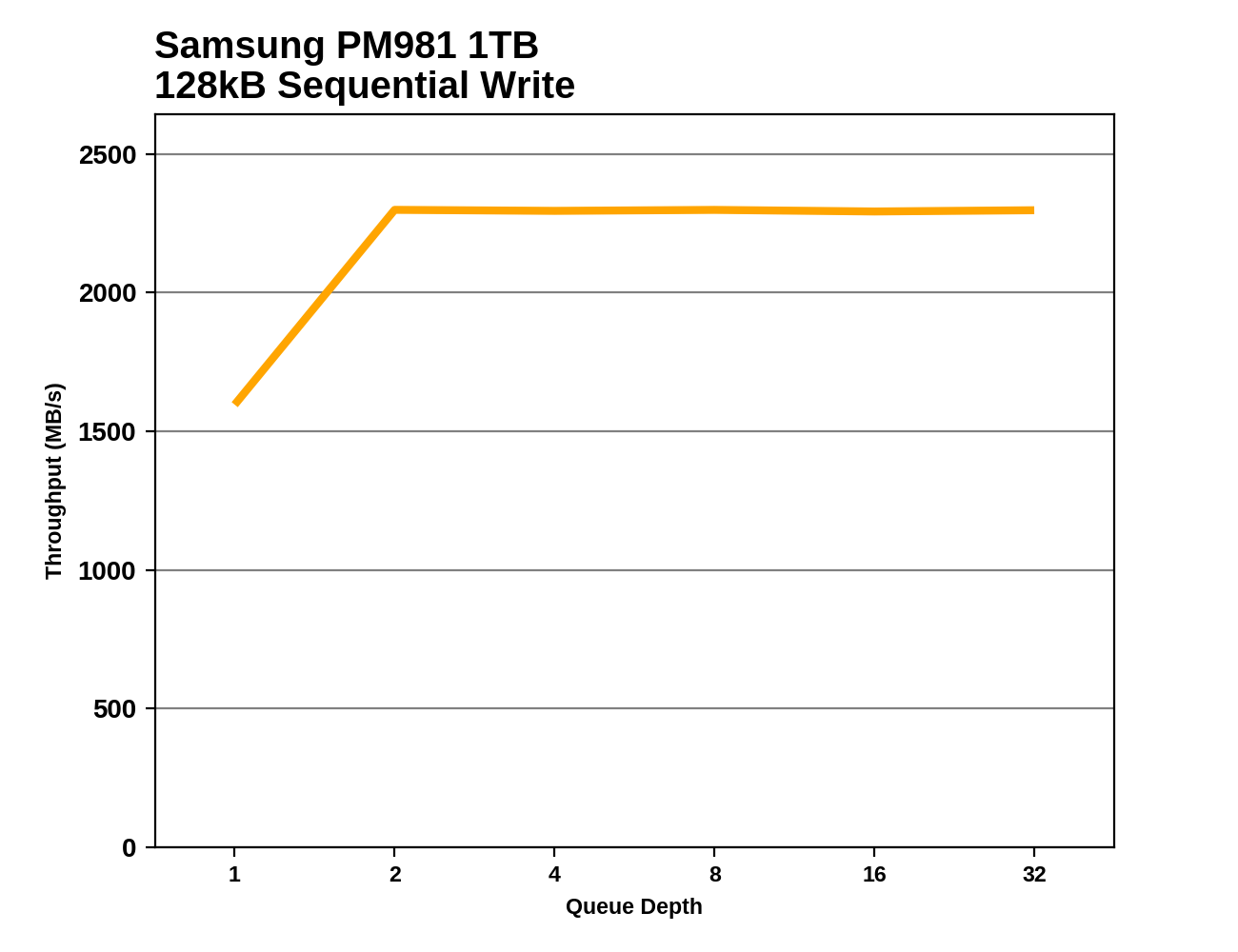The Samsung PM981 SSD Review (512GB, 1TB): Next Generation Controller And 3D NAND
by Billy Tallis on November 30, 2017 9:02 AM ESTSequential Read Performance
Our first test of sequential read performance uses short bursts of 128MB, issued as 128kB operations with no queuing. The test averages performance across eight bursts for a total of 1GB of data transferred from a drive containing 16GB of data. Between each burst the drive is given enough idle time to keep the overall duty cycle at 20%.

The burst sequential read performance of the Samsung PM981 doesn't quite set a new record, but it's pretty close to the top performer and very far ahead of any non-Samsung drive.
Our test of sustained sequential reads uses queue depths from 1 to 32, with the performance and power scores computed as the average of QD1, QD2 and QD4. Each queue depth is tested for up to one minute or 32GB transferred, from a drive containing 64GB of data.

On the longer test with higher queue depths, the best MLC-based drives pull ahead of the PM981 and even the 960 EVO has a slight advantage.
 |
|||||||||
The 1TB PM981 starts out with almost the same performance as the 1TB 960 EVO, but the PM981's performance falls off a bit during the first half of the test while the 960 EVO remains steady. The 512GB PM981 doesn't experience any slowdown, but it is slower than the 1TB model throughout the test.
Sequential Write Performance
Our test of sequential write burst performance is structured identically to the sequential read burst performance test save for the direction of the data transfer. Each burst writes 128MB as 128kB operations issued at QD1, for a total of 1GB of data written to a drive containing 16GB of data.

The PM981s both deliver the same record-setting burst sequential write performance that is a marked improvement over the best of Samsung's last generation, and far ahead of any competing flash-based SSD.
Our test of sustained sequential writes is structured identically to our sustained sequential read test, save for the direction of the data transfers. Queue depths range from 1 to 32 and each queue depth is tested for up to one minute or 32GB, followed by up to one minute of idle time for the drive to cool off and perform garbage collection. The test is confined to a 64GB span of the drive.

On the longer sequential write test, the 512GB PM981 falls behind most of the rest of the Samsung drives but the 1TB model remains on top, ahead of even the 960 PROs.
 |
|||||||||
The 1TB PM981 hits full write speed at QD2 and stays there for the rest of the test, holding on to its lead over the 960 PRO. The 512GB PM981 runs out of SLC write cache early on and its performance bounces around with the garbage collection cycles.










53 Comments
View All Comments
msroadkill612 - Sunday, December 31, 2017 - link
Not if you have lane rich TR/Epyc IMO. 2x 512GB 960 proS in raid 0 is 2x~ faster for similar moneymsroadkill612 - Monday, January 1, 2018 - link
It bears noting that each ssd is also a controller, and the samsung one seems very superior kit which may contribute to samsung's scary advantages.Each is a 5x ARM core processor.
msroadkill612 - Monday, January 1, 2018 - link
To be the devils advocate on TLC vs MLC, isn't it odd to second guess samsung?AMD natively demonstrate that raid striping nvme (running them in parallel if u like?), results in ~seamless multiple of raw nvme ssd speeds.
Since current samsung drives individually ~max out the 4x pcie3practical bandwidth available to the m.2 port (~3500MB/s), the ceiling on nvme device speeds currently, is not set by nand, but by IO limitations.
Given multiples of speed can be achieved by raid means , the main issue is not nand chip performance (already dazzlingly fast vs recent storage options), but how to better satisfy insatiable demand using better production.
Personally, I would defer to samsung on that.